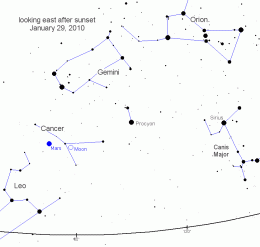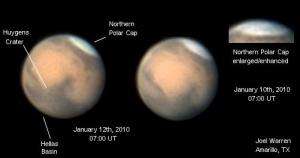Close Encounter with Mars

It rises in the east at sunset, pumpkin-orange and brighter than a first magnitude star. You stare at it, unblinking. Unblinking, it stares right back. It is Mars.
This week Earth and Mars are having a close encounter. On Jan. 27th, the Red Planet will be only 99 million kilometers away and look bigger through a telescope than at any time between 2008 and 2014. The planet's 14-arcsecond diameter will remain essentially unchanged for another week or so, setting the stage for some good observing.
"Mars is an excellent target for all backyard telescopes right now," reports amateur astronomer Joel Warren, who sends these pictures from his observatory in Amarillo, Texas:

"The planet's North Polar Cap was brilliant in my 11-inch reflector," he says.
And because summer is coming to the Martian north, the bright polar cap and its icy-blue clouds are shifting, sublimating and changing every night. It's a lively show for anyone with a mid-sized telescope and a digital camera.
But a telescope is not required to enjoy the show. Mars is a pleasing sight even to the unaided eye. With a visual magnitude of -1.3, it is almost as bright as Sirius (magnitude -1.44), the brightest star in the sky.
Compare the two—Sirius vs. Mars. They are in the same patch of sky all week long. While Sirius is as blue as the tip of an acetylene torch, Mars looks more like the ruddy head of a lit match. The contrast is beautiful.
Another fun comparison: Sirius twinkles but Mars does not. Distant, pinprick stars are more disturbed in their appearance by tiny irregularities in Earth's atmosphere than nearby, disk-shaped planets. Compared to the dancing light of a star, Mars has a smooth, unblinking glow.
For visual observers, the best display comes on Friday, Jan. 29th, when the full Moon and Mars converge for a floodlamp-bright conjunction. On that night, Mars will be at opposition—i.e., directly opposite the sun. It will rise alongside the Moon at sunset and soar overhead at midnight, never straying more than about 6o from the first full Moon of 2010. (Note: Contrary to "Mars Hoax" emails, Mars will not be as wide as the full Moon. To the unaided eye, Mars will resemble a bright orange star.)
Earth and Mars have close encounters approximately every 26 months. Some are closer than others, however. In 2003, the Earth-Mars distance was only 56 million kilometers, a sixty-thousand year minimum. The whole world stopped to watch as news reports trumpeted the event. This year's gulf is almost twice as wide, and professional astronomers do not consider it a particularly remarkable encounter.
Don't let that stop you. Mars is near. Take a look!
Provided by Science@NASA, by Dr. Tony Phillips


















